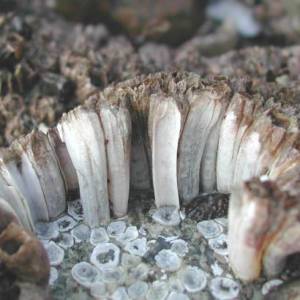Table of Contents
Group 10
<html><font size=6 face=“Arial”>Fear of the Crab </font></html>
Wiki site of the practical exercise of the VIII Southern-Summer School on Mathematical Biology.
Here you will find the exercise assignment and the group's products.
If you are a group member login to edit this page, create new pages from it, and upload files.
Introduction
In a food chain, a top predator has a direct effect on the abundances of the species it preys on, but its presence might also result in other nonconsumptive effects (“NCEs”). For instance, intermediate consumers might change their foraging behaviour due to the risk of predation. The effect of predator presence thus propagates down the food-chain in many ways, and basal resources might also change their behaviour as a consequence of changes in higher trophic levels.
The green crab Carcinus maenas is an example of a top predator which provokes fear-induced behavioural changes in its prey, such as snails Nucella lapillus. These snails usually forage on barnacles (such as Semibalanus balanoides) and compete among themselves for the preys. The barnacles also compete among themselves for resources and space, which is highlighted by hummocking - the individuals change their geometry, forming small mounts and growing taller (see Figure 1).
<WRAP clear></WRAP> <WRAP third column left>Figure 1: Balanus glandula (Acorn barnacle) hummock transversal view - similar to S. balanoides hummocks (source).</WRAP> <WRAP clear></WRAP>
Experiments have been developed to assess the propagation of the nonconsumptive predator effects through food-chain and its interplay with intra-specific competition. The joint effect of competition, predation and fear among snails and that of competition, predation and indirect effects among barnacles might result in different scenarios, depending on the intensities and mechanism of each process.
Matassa et al. (2018) found that the competition among barnacles was dependent on the predation risk upon snails, suggesting a coupling between behaviours across trophic levels. The authors also assessed the competition among snails and verified that its intensity was dependent on NCE's from top predators, but not from prey availability. Additionally, it was found that in a high Nucella lapillus density context, the S. balanoides population was more depleted when no Carcinus maenas individual was present, but in a low Nucella lapillus context the resource depletion was equivalent in both contexts.
Assignment
Build a mathematical model of the dynamics of this biological system. Analyze the model and use it to formulate and answer questions you may find along the way.
Suggested Questions
- Does your model reproduce the non-consumptive effects on resource depletion found in experiments? Is this resource depletion dependent on the intermediate consumers population, as observed by Matassa et al. (2018) ?
- What kind of dynamics can be predicted by a mathematical model of this interaction? Does the model recovers observed behaviour for realistic values of the key parameters?
- By changing their behaviour, the snails favour a decrease in their mortality in face of an increased food intake. Does the model provide insights on this strategy?
- Considering a scenario in which the experiment performed by Matassa et al. (2018) (see ref. below) allowed for consumptive predator effects from the C. maenas upon the N. lapillus, what qualitative changes on dynamics could be expected?
References
- Matassa, C.M., Ewanchuk, P.J., Trussell, G.C., 2018. Cascading effects of a top predator on intraspecific competition at intermediate and basal trophic levels. Functional Ecology 32, 2241–2252. https://doi.org/10.1111/1365-2435.13131
- Donelan, S.C., Grabowski, J.H., Trussell, G.C., 2017. Refuge quality impacts the strength of nonconsumptive effects on prey. Ecology 98, 403–411. https://doi.org/10.1002/ecy.1647
- Matassa, C.M., Donelan, S.C., Luttbeg, B., Trussell, G.C., 2016. Resource levels and prey state influence antipredator behavior and the strength of nonconsumptive predator effects. Oikos 125, 1478–1488. https://doi.org/10.1111/oik.03165

